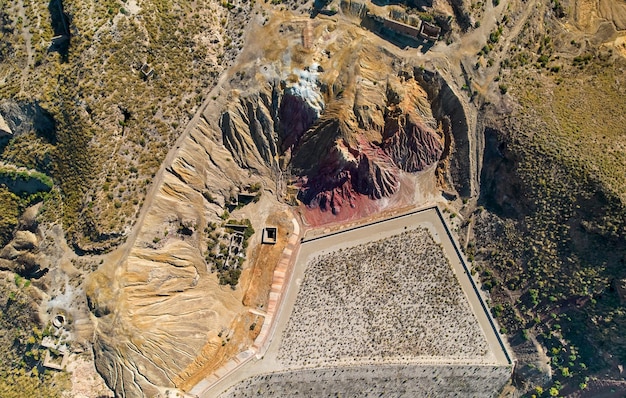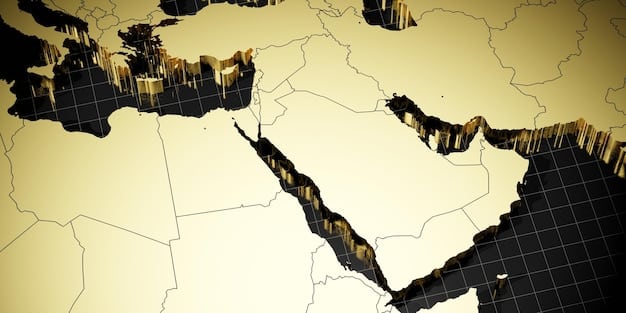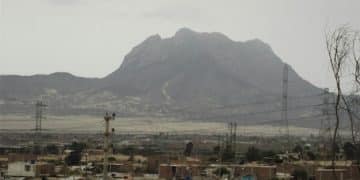US Withdrawal from Iran Nuclear Deal: Potential Consequences

The potential consequences of the US withdrawal from the Iran Nuclear Deal include Iran restarting its nuclear program, increased regional instability, strained international relations, and potential economic repercussions for all involved.
The potential consequences of the US withdrawal from the Iran Nuclear Deal are far-reaching and complex, impacting not only Iran and the United States but also the broader international community. Understanding these consequences is crucial for navigating the current geopolitical landscape.
Understanding the Iran Nuclear Deal: A Brief Overview
The Iran Nuclear Deal, formally known as the Joint Comprehensive Plan of Action (JCPOA), was a landmark agreement reached in 2015. It involved Iran and the P5+1 countries (the United States, United Kingdom, France, China, and Russia, plus Germany) and the European Union. The goal was to prevent Iran from developing nuclear weapons in exchange for the lifting of economic sanctions.
Key Provisions of the JCPOA
The JCPOA placed significant restrictions on Iran’s nuclear program. These restrictions were designed to make it difficult, if not impossible, for Iran to quickly develop nuclear weapons. Key provisions included:
- Limits on Uranium Enrichment: Iran agreed to limit its uranium enrichment levels, preventing it from producing highly enriched uranium suitable for nuclear weapons.
- Inspections by the IAEA: The International Atomic Energy Agency (IAEA) was granted extensive access to Iran’s nuclear facilities to verify compliance with the agreement.
- Reductions in Centrifuges: Iran significantly reduced the number of centrifuges it possessed, which are used to enrich uranium.
- Conversion of Nuclear Facilities: Some of Iran’s nuclear facilities were converted for peaceful purposes, such as research and medical isotope production.
The JCPOA was hailed as a major diplomatic achievement at the time, averting a potential crisis in the Middle East and preventing the proliferation of nuclear weapons. However, the agreement was not without its critics, particularly in the United States and Israel.
The Iran Nuclear Deal sought to ensure that Iran’s nuclear program remained peaceful, verifiable, and transparent. Its collapse has created significant uncertainty and heightened tensions in the region and beyond.

The US Withdrawal: Reasons and Motivations
In 2018, the United States, under the Trump administration, unilaterally withdrew from the JCPOA. This decision marked a significant shift in US foreign policy and had profound implications for the future of the agreement and the region. Several reasons and motivations were cited for the withdrawal.
Criticisms of the JCPOA
The Trump administration argued that the JCPOA was fundamentally flawed. Key criticisms included:
- Sunset Clauses: The agreement contained “sunset clauses” that would eventually allow Iran to resume certain nuclear activities after a specified period. Critics argued that these clauses were unacceptable and would eventually allow Iran to develop nuclear weapons.
- Failure to Address Other Issues: The JCPOA focused solely on Iran’s nuclear program and did not address other concerns, such as Iran’s ballistic missile program and its support for regional proxies.
- Verification Concerns: Some critics questioned the effectiveness of the IAEA’s verification mechanisms, arguing that Iran could still secretly pursue nuclear weapons development.
- Economic Benefits for Iran: The lifting of economic sanctions under the JCPOA provided Iran with significant economic benefits, which critics argued were used to support destabilizing activities in the region.
The Trump administration also argued that the JCPOA was too lenient on Iran and did not sufficiently deter its aggressive behavior in the Middle East. The withdrawal was intended to exert maximum pressure on Iran and force it to renegotiate a “better deal.”
The US withdrawal from the JCPOA was based on deep skepticism about the agreement’s effectiveness and a desire to pursue a more confrontational approach towards Iran. This decision has had far-reaching consequences.
Iran’s Response: Nuclear Program and Regional Activities
Following the US withdrawal from the JCPOA, Iran gradually began to roll back its commitments under the agreement. This was a direct response to the reimposition of US sanctions and the failure of other parties to provide Iran with the promised economic relief.
Escalation of Nuclear Activities
In response to the US withdrawal and the reimposition of sanctions, Iran took several steps to increase its nuclear activities. These steps included:
- Increasing Uranium Enrichment: Iran began to enrich uranium to higher levels than allowed under the JCPOA.
- Expanding Centrifuge Capacity: Iran increased the number of centrifuges it possessed and began to use more advanced centrifuges.
- Resuming Activities at Fordow: Iran resumed uranium enrichment activities at its Fordow facility, which was previously limited under the JCPOA.
- Reducing Cooperation with the IAEA: Iran reduced its cooperation with the IAEA, limiting access to certain nuclear facilities and hindering verification efforts.
These actions have raised serious concerns about Iran’s intentions and its ability to quickly develop nuclear weapons. The international community has repeatedly called on Iran to return to full compliance with the JCPOA.
Iran’s response to the US withdrawal has been to gradually reduce its commitments under the JCPOA, raising concerns about its nuclear ambitions and the potential for a nuclear arms race in the Middle East.

Regional Instability: Increased Tensions and Conflicts
The US withdrawal from the JCPOA has contributed to increased regional instability and heightened tensions in the Middle East. With the deal in tatters, it has emboldened certain factions and destabilized the region’s balance of power.
The unraveling of the JCPOA has fueled regional conflicts and proxy wars. With Iran feeling less constrained by international oversight, it has become more assertive in its foreign policy, leading to increased involvement in regional conflicts such as those in Syria, Yemen, and Iraq.
Proxy Wars and Regional Conflicts
With weakened nuclear monitoring, regional conflicts have increased including:
- Increased tensions with Saudi Arabia and allies
- Proxy wars in Yemen have escalated
- Concerns about stability in Lebanon and Iraq
These tensions have led to increased military spending, a greater risk of miscalculation, and the potential for escalation into larger conflicts. The withdrawal from the JCPOA has created a more volatile and dangerous environment in the Middle East.
The US withdrawal from the JCPOA has contributed to increased regional instability and heightened tensions in the Middle East. This has led to increased military spending, a greater risk of miscalculation, and the potential for escalation into larger conflicts.
International Relations: Strained Alliances and Diplomatic Challenges
The US withdrawal from the JCPOA has strained international relations and created diplomatic challenges. The decision was met with widespread criticism from key allies, who viewed the agreement as a crucial tool for preventing nuclear proliferation and maintaining regional stability.
Divergence with European Allies
The US withdrawal from the JCPOA has created a significant divergence with European allies. The European Union and its member states have consistently reaffirmed their commitment to the agreement and have worked to preserve it despite US sanctions. This has led to tensions between the US and its traditional allies.
The EU has tried to navigate the situation but faces an up-hill battle:
- Economic issues stemming from the US sanctions
- Differing perspectives on Iran’s role in the Middle East
- Maintaining diplomatic ties with all parties
The US withdrawal from the JCPOA has strained international relations and created diplomatic challenges. The decision was met with widespread criticism from key allies, who viewed the agreement as a crucial tool for preventing nuclear proliferation and maintaining regional stability.
Economic Repercussions: Sanctions and Global Markets
The reimposition of US sanctions on Iran following the withdrawal from the JCPOA has had significant economic repercussions. These sanctions have targeted Iran’s oil exports, banking sector, and other key industries, causing a sharp decline in its economy.
Impact on Iran’s Economy
The reimposition of US sanctions has had a devastating impact on Iran’s economy. The sanctions have led to:
- Decline in Oil Exports: Iran’s oil exports have plummeted, depriving the country of a major source of revenue.
- Currency Depreciation: The Iranian currency has depreciated sharply, leading to inflation and economic hardship.
- Reduced Foreign Investment: Foreign investment in Iran has dried up, further weakening the economy.
- Increased Unemployment: Unemployment has risen as businesses struggle to cope with the sanctions.
The sanctions have also had knock-on effects on global markets, particularly in the energy sector. The reduction in Iranian oil exports has contributed to higher oil prices, impacting consumers and businesses around the world.
The reimposition of US sanctions on Iran has had significant economic repercussions, leading to a sharp decline in Iran’s economy and impacting global markets.
| Key Point | Brief Description |
|---|---|
| ☢️ Nuclear Program Restart | Iran resumes enriching uranium, raising proliferation concerns. |
| ⚔️ Regional Instability | Heightened tensions and conflicts in the Middle East. |
| 🤝 Strained Relations | US faces diplomatic challenges with allies over Iran policy. |
| 💰 Economic Impact | Sanctions cripple Iran’s economy, affecting global markets. |
Frequently Asked Questions
▼
The main goal was to prevent Iran from developing nuclear weapons by placing restrictions on its nuclear program in exchange for lifting economic sanctions.
▼
The US withdrew due to concerns over sunset clauses, Iran’s ballistic missile program, and its regional activities, aiming to exert maximum pressure.
▼
Iran has gradually rolled back its commitments under the JCPOA, increasing uranium enrichment and reducing cooperation with the IAEA.
▼
Potential consequences include an increased risk of nuclear proliferation, heightened regional tensions, and further economic instability.
▼
The reimposition of US sanctions has led to a sharp decline in Iran’s economy and has affected global markets, especially in the energy sector.
Conclusion
The US withdrawal from the Iran Nuclear Deal has set in motion a series of events with far-reaching and complex consequences. The risk of nuclear proliferation has increased, regional tensions have escalated, and international relations have been strained. Addressing these challenges requires a renewed commitment to dialogue, diplomacy, and multilateral cooperation.





